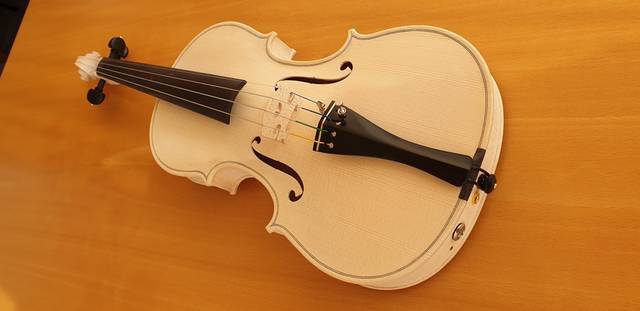STRING MUSICAL INSTRUMENT WITH BIMODAL OPERATION
Description
The present invention relates to the instruments of the string quartet, with special mention to the violin for being the most representative of them, with bimodal operation. These instruments allow the player to obtain the same sound and feeling as when playing a classical instrument, but also include the possibility of sending the sound wirelessly to a receiver that can be connected to an amplifier, a mixer, a recording system, a streaming system, etc., so that it adds all the options of an electric instrument to those of the classical one. The present invention is applied to all instruments of the string quartet: violin, viola, cello and double bass. We call it bimodal violin or b-violin because it is the most representative instrument of this set of musical instruments.
Advantages
Currently there is a wide variety of designs of electric violins, whose purpose is to allow the sound of the violin to be amplified and processed or modified in a similar way to other instruments, such as the electric guitar. These instruments have several drawbacks for the violin player and the production of sound:
1) The feeling of the sound that the performer receives is very different from that of playing a classical violin since, by design, they do not usually have a soundboard. This means that if they are not connected to an amplifier, they produce no sound and when they are connected to the amplifier the sound is not comparable to that of the classical violin either.
2) They cannot be used as a classical violin. They need to have a cable connected to the amplifier for sound transmission, so they are uncomfortable to play.
3) In many cases, the weight of the violin is higher than that of the classical violin, so it is not comfortable to play and the feeling that the player perceives is very different.
4) The design of the bridge is different to adapt them to their electrical operation, so although the design of the electric violin may maintain the shape of the classical violin, again the feeling and sound with or without connection is different for the player and the way to adjust the sound quality of the instrument is different from that of a classical violin.
There are also microphones that can be adapted to the violin to collect its sound to be amplified and allow its integration into spectacles that need a large volume of sound. The addition of a microphone to the violin means the addition of a foreign element to the violin, along with cables needed to connect the microphone, part on the violin and part on the performer''s clothing, which is unsightly and can be uncomfortable for the performer.
Uses and Applications
String musical instrument with bimodal operation.The main applications are:
1) High quality amplification of the instrument signal. The design of the system and the position of the microphone make the signal of the instrument to be captured and transmitted without external noises and with high quality.
2) Integration of the sound of the violin, or instrument of the string quartet, with any type of musical instrument, acoustic or electronic, since its signal is transmitted wirelessly to amplifiers, mixing tables, etc.
3) Recording of the signal of the instrument with high quality and without noise in any environment since the capture system included in the bimodal instrument is highly immune to the noise of the environment.
4) Transmission of the sound of violin or bimodal instrument in any environment with quality.
Uses:Operation in bimodal mode. In this mode the instrument of the string quartet, in addition to sounding like a classical instrument, wirelessly sends its audio signal to an amplifier, a mixing desk, a recording system, a communications system, etc., so that it can be processed with effects, amplified, mixed with other instruments, etc.
Keywords
Sectors
Areas
Patent Number
ES1311912U Expediente
Applicants
UNIVERSIDAD DE MÁLAGA
Inventors
LORENZO JOSE TARDON GARCIA, ISABEL BARBANCHO PEREZ, ANA MARIA BARBANCHO PEREZ, JORGE LUIS MOLINA CANO, JOSÉ ÁNGEL CHACÓN ESCOBAR
Filing Date
29/07/2021
Protection Level: National (Spain)
Processing Status: Spanish utility model








